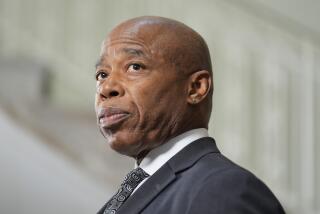U.S. Should Lead in World Debt Crisis
The following is adapted from a statement by the executive committee of the Inter-American Dialogue, a group of opinion leaders from throughout the hemisphere who met in Washington last week. The dialogue co-chairmen are former U.S. Ambassador Sol M. Linowitz and Galo M. Plaza, former president of Ecuador.
A variety of plans have been put forth that address Latin America’s debt problems, and the cornerstone of every one of them is sustained economic growth in the region. And there is no dispute over what is required to achieve growth: Latin American countries must improve the management of their economies, and they must have increased external resources.
This consensus on fundamentals must now be translated into action. That will take decisive political leadership, which must first come from the United States as the world’s leading industrial power. U.S. actions must be reinforced by government initiatives in Japan and Western Europe as well as in Latin America, but it is up to Washington to take the lead.
When Treasury Secretary James A. Baker III presented the United States’ recommendations in October, 1985, the initiative was welcomed as a belated step toward coming to grips with Third World debt problems. It was clear even then that the so-called Baker plan offered too little capital to get Latin America very far down the road to recovery, and that it would have to be supplemented. But before any plan can be supplemented it must be implemented. The Baker proposals are mostly still that--proposals--a year after they were put forward.
Most Latin American countries have undertaken programs of economic reform and adjustment consistent with the Baker plan. With varying degrees of success they have expanded their exports, devalued their currencies, reduced public spending, curbed inflation and moved toward greater reliance on the private sector. In doing so they have strengthened their ability to make effective use of external capital. They have not, however, gained access to that capital, which they need for vital imports and new investments to reconstruct their economies. This is the major obstacle to recovery in Latin America.
The Baker plan, like most other debt proposals, looked to the commercial banks as the principal source of new financing. Baker called on the banks to increase Third World loans by a modest 2.5% per year. Instead, in the past year they have reduced their net lending to Latin America and other debtor nations.
Since 1982 the banks have greatly improved their financial position. If Latin American countries are now better able to use new loans, the banks are in a stronger position to provide those loans and to participate in other ways to remedy the region’s debt situation. Their participation is essential if Latin America is to secure the additional $20 billion per year that it needs to resume sustainable growth. There is wide agreement on this target figure among the international financial institutions and independent policy analysts. No debt-management plan can work without the cooperation of the commercial banks.
Political leadership is key to gaining that cooperation. The United States and other industrial nations must take a more active role in international debt negotiations. Their backing was crucial in the shaping of the recently agreed package of loans to Mexico. These governments must now work to encourage banks to renew lending elsewhere in Latin America, and to undertake other critical initiatives--restructuring existing loans, stepping up debt-for-equity swaps and writing off some loans to countries that cannot otherwise cope with their debts.
Government action also is necessary to modify banking regulations that make it burdensome and costly for private banks to participate in such initiatives. Regulations should allow banks to capitalize interest payments without penalty, and to absorb losses over an extended period on loans that they write down. Loan guarantees, co-financing and other positive incentives will also be necessary to promote bank cooperation. Official risk-sharing with the commercial banks is necessary to mobilize their resources.
The United States and all member countries should also increase their commitments to the international financial institutions. The International Monetary Fund, the World Bank and the Inter-American Development Bank are central to any long-term recovery program for Latin America. Their expanded participation would further reassure commercial banks that the financial burden is being appropriately shared by official agencies.
Above all else, political leadership is needed to resist pressures for additional trade restrictions. Nothing would cripple Latin America’s chances for recovery more than new obstacles to its exports.
Protectionist pressures are likely to increase in the new U.S. Congress. The Administration must continue to search for ways other than erecting import barriers to confront this country’s huge trade deficit and its debilitating effects on U.S. workers and businesses.
In fact, world markets must be opened further. With expanded markets for its products, Latin America will be better able to meet its debt obligations, to reestablish long-term growth and to buy goods from the United States. Every dollar that Latin America gains in trade is a dollar available to pay interest and purchase imports. Expanded trade is to everyone’s advantage, as is recovery in Latin America. They go hand in hand.
Latin America’s debt crisis can be resolved and economic vitality can be restored to the region. What it will take is political leadership to put sound policies into practice. The announcement of the Baker plan a year ago raised expectations that the U.S. government had finally committed itself to an active leadership role in confronting international debt. It is now high time to assert that leadership.
More to Read
Sign up for Essential California
The most important California stories and recommendations in your inbox every morning.
You may occasionally receive promotional content from the Los Angeles Times.










